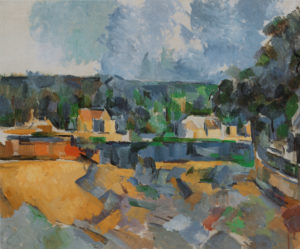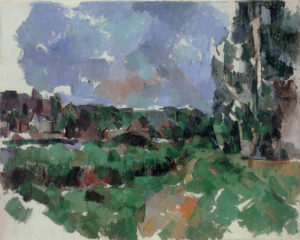R920 – Bords d’une rivière, vers 1904 (FWN369)
R922- Paysage au bord d’une rivière, vers 1904 (FWN371)
Pavel Machotka
(Cliquer sur les images pour les agrandir)
The composition of the contemporary Bords d’une rivière is at first sight similar to that of Paysage au bord d’une rivière and the vertex where the horizontals and diagonals meet is located in the same spot. The patches seems to be closer together, given the grey background. The crucial difference is in their orientation: here, in the middle band, they are vertical and horizontal. Surely the clear view of the river helped Cézanne decide what patches to use: what we see, in any case, is a painting that is firmly composed, its tense choppiness well resolved, and its welter of patches clarified by an occasional outline. The terrace on the right meets the river at a point, and by meeting it points more firmly to the left; so do most of the confused patches on the ground. On the left a happy, commanding patch of red draws us away from the congested bottom (and, of course, balances the colors). The occasional outlines that border the houses, the river, the red barge, and even the horizon—added after the fact—help the middle band give the painting stability and respite. We must understand that the statement « as one paints, one also draws » is only an approximation; in this painting (and others), what Cézanne did was to compose as he painted, and he clarified the drawing later, with an occasional outline, as needed.
Source: Machotka, Cézanne: The eye and the Mind.



